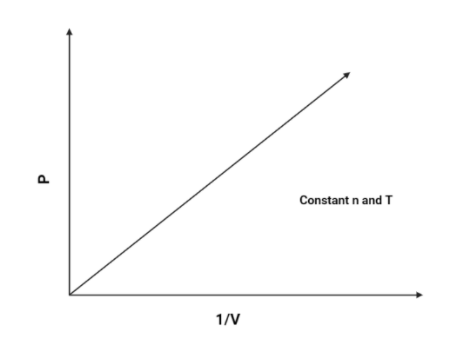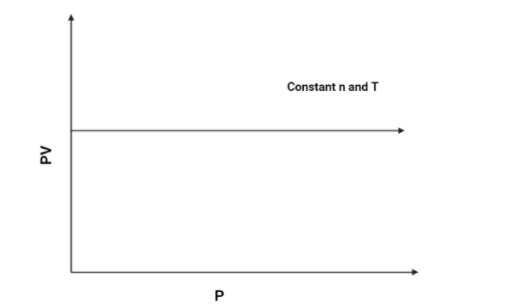
Plot the following graphs:
1. $P$ vs $V$
2. $P$ vs $\dfrac{1}{V}$
3. $PV$ vs $P$
Answer
520.8k+ views
Hint: Boyle’s law helps in understanding the behaviour of gases when the temperature is constant. It states that the pressure of the gas is inversely proportional to its volume when the temperature is constant.
$
P\propto V \\
P = \dfrac{k}{V} \\
PV = k \\
$Where $V$ is the volume, $P$ is the pressure and $k$ is the constant value
Complete step by step solution:
1. $P$ vs $V$:
As we know that pressure and volume of a gas is inversely proportional (According to Boyle’s law), Hence, pressure will increase as the volume decreases. The graph is as follows:

Hence, The graph of pressure vs volume will be a rectangular hyperbola.
2. $P$ vs $\dfrac{1}{V}$:
As we know that $P$ and $\dfrac{1}{V}$ is directly proportional (According to boyle’s law), Hence, pressure will increase as the volume increases.The graph is as follows:

Hence, The graph of $P$ vs $\dfrac{1}{V}$ will be a linear graph.
3. $PV$ vs $P$:
As we know that $PV = k$, (According to Boyle's law). Hence the $PV$ axis will remain constant for all values of $P$. The graph is as follows:

Hence, The graph of $PV$ vs $P$ will be a constant graph.
Note: Boyle’s law has many real life applications. For example, It’s being used in the medical field to check the breathing system in the human body. It helps in explaining how the air pressure within our lungs increases or decreases with respect to the volume of our lungs. This results in the difference in air pressure within our lungs and the environmental air.
$
P\propto V \\
P = \dfrac{k}{V} \\
PV = k \\
$Where $V$ is the volume, $P$ is the pressure and $k$ is the constant value
Complete step by step solution:
1. $P$ vs $V$:
As we know that pressure and volume of a gas is inversely proportional (According to Boyle’s law), Hence, pressure will increase as the volume decreases. The graph is as follows:

Hence, The graph of pressure vs volume will be a rectangular hyperbola.
2. $P$ vs $\dfrac{1}{V}$:
As we know that $P$ and $\dfrac{1}{V}$ is directly proportional (According to boyle’s law), Hence, pressure will increase as the volume increases.The graph is as follows:

Hence, The graph of $P$ vs $\dfrac{1}{V}$ will be a linear graph.
3. $PV$ vs $P$:
As we know that $PV = k$, (According to Boyle's law). Hence the $PV$ axis will remain constant for all values of $P$. The graph is as follows:

Hence, The graph of $PV$ vs $P$ will be a constant graph.
Note: Boyle’s law has many real life applications. For example, It’s being used in the medical field to check the breathing system in the human body. It helps in explaining how the air pressure within our lungs increases or decreases with respect to the volume of our lungs. This results in the difference in air pressure within our lungs and the environmental air.
Recently Updated Pages
Why are manures considered better than fertilizers class 11 biology CBSE

Find the coordinates of the midpoint of the line segment class 11 maths CBSE

Distinguish between static friction limiting friction class 11 physics CBSE

The Chairman of the constituent Assembly was A Jawaharlal class 11 social science CBSE

The first National Commission on Labour NCL submitted class 11 social science CBSE

Number of all subshell of n + l 7 is A 4 B 5 C 6 D class 11 chemistry CBSE

Trending doubts
What is meant by exothermic and endothermic reactions class 11 chemistry CBSE

10 examples of friction in our daily life

One Metric ton is equal to kg A 10000 B 1000 C 100 class 11 physics CBSE

1 Quintal is equal to a 110 kg b 10 kg c 100kg d 1000 class 11 physics CBSE

Difference Between Prokaryotic Cells and Eukaryotic Cells

What are Quantum numbers Explain the quantum number class 11 chemistry CBSE




